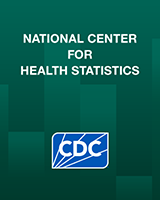
NCBI Bookshelf. A service of the National Library of Medicine, National Institutes of Health.
Prevalence of adults aged 20 and over with diabetes, by demographic characteristics: United States, 2017–March 2020
| Characteristic | Both sexes | Men | Women | |||
|---|---|---|---|---|---|---|
| Sample size | Prevalence percentage (95% confidence interval) | Sample size | Prevalence percentage (95% confidence interval) | Sample size | Prevalence percentage (95% confidence interval) | |
| Total (age adjusted) | 3,757 | 14.8 (13.1–16.7) | 1,817 | 16.3 (14.2–18.7) | 1,940 | 113.4 (11.0–16.1) |
| Total (crude) | 3,757 | 16.2 (14.2–18.3) | 1,817 | 17.7 (15.5–20.2) | 1,940 | 14.8 (12.2–17.7) |
| Age group (years): | ||||||
| 20–39 | 1,100 | 24.4 (2.9–6.2) | 520 | *,24.0 (1.7–7.9) | 580 | 24.7 (3.1–6.9) |
| 40–59 | 1,279 | 16.4 (13.4–19.9) | 594 | 17.1 (12.8–22.1) | 685 | 15.9 (10.9–21.9) |
| 60 and over | 1,378 | 30.0 (27.2–32.9) | 703 | 36.3 (30.8–42.1) | 675 | 124.4 (19.4–30.1) |
| Race and Hispanic origin: | ||||||
| Non-Hispanic white | 1,275 | 3–512.0 (9.4–15.0) | 649 | 3–513.6 (10.0–17.9) | 626 | 3–510.6 (7.6–14.4) |
| Non-Hispanic black | 933 | 18.8 (16.4–21.5) | 442 | 18.9 (15.3–22.9) | 491 | 18.7 (15.3–22.4) |
| Non-Hispanic Asian | 478 | 18.1 (14.4–22.3) | 211 | 20.7 (14.2–28.4) | 267 | 15.8 (11.7–20.8) |
| Hispanic | 872 | 21.2 (18.3–24.3) | 414 | 23.5 (19.0–28.5) | 458 | 19.2 (15.5–23.5) |
| Family income relative to federal poverty level (FPL): | ||||||
| 130% or less FPL | 887 | 620.0 (16.8–23.6) | 390 | 621.7 (16.3–28.0) | 497 | 618.7 (14.3–23.8) |
| More than 130% through 350% FPL | 1,305 | 17.7 (14.8–20.9) | 644 | 18.5 (14.7–22.8) | 661 | 17.1 (12.5–22.4) |
| More than 350% FPL | 1,062 | 10.9 (8.3–14.0) | 543 | 13.7 (10.0–18.2) | 519 | 18.1 (5.6–11.3) |
| Education: | ||||||
| Less than high school diploma | 730 | 722.7 (19.1–26.7) | 375 | 721.7 (16.4–27.8) | 355 | 724.0 (17.9–31.0) |
| High school diploma or some college | 2,103 | 15.7 (13.3–18.3) | 992 | 16.3 (13.0–20.1) | 1,111 | 15.2 (12.2–18.5) |
| College degree or above | 921 | 10.4 (7.7–13.7) | 447 | 14.2 (9.6–19.8) | 474 | 16.8 (4.3–10.2) |
| Weight status:8 | ||||||
| Normal weight (BMI 18.5–24.9) | 892 | 96.6 (4.0–10.0) | 420 | 99.0 (4.6–15.5) | 472 | 94.9 (2.5–8.5) |
| Overweight (BMI 25.0–29.9) | 1,193 | 10.3 (8.4–12.3) | 669 | 12.7 (9.3–16.8) | 524 | 17.4 (4.9–10.7) |
| Obesity (BMI 30.0 and higher) | 1,565 | 23.3 (20.3–26.6) | 677 | 24.0 (19.7–28.8) | 888 | 22.8 (18.3–27.8) |
Estimate does not meet National Center for Health Statistics standards of reliability.
Significantly different from men.
Significantly increasing trend with increasing age.
Significantly different from non-Hispanic black adults.
Significantly different from non-Hispanic Asian adults.
Significantly different from Hispanic adults.
Significantly decreasing trend with increasing family income.
Significantly decreasing trend with increasing education.
Pregnant women of all ages were excluded from the analysis by weight status.
Significantly increasing trend with increasing weight status.
NOTES: Diabetes is defined as having answered “yes” to a question asking if they have been told they have diabetes, have a fasting plasma glucose greater than or equal to 126 mg/dL, or have a hemoglobin A1c greater than or equal to 6.5%. Fasting weights were used. Except where reported as crude estimates, estimates were age adjusted by the direct method to the projected U.S. Census 2000 population using the age groups 20–39, 40–59, and 60 and over. Statistical comparisons were not performed on crude estimates. Pregnant women aged 20–44 years were excluded from the analysis. BMI (body mass index) is measured in kg/m2.
SOURCE: National Center for Health Statistics, National Health and Nutrition Examination Survey, 2017–March 2020 prepandemic data files.

NCBI Bookshelf. A service of the National Library of Medicine, National Institutes of Health.